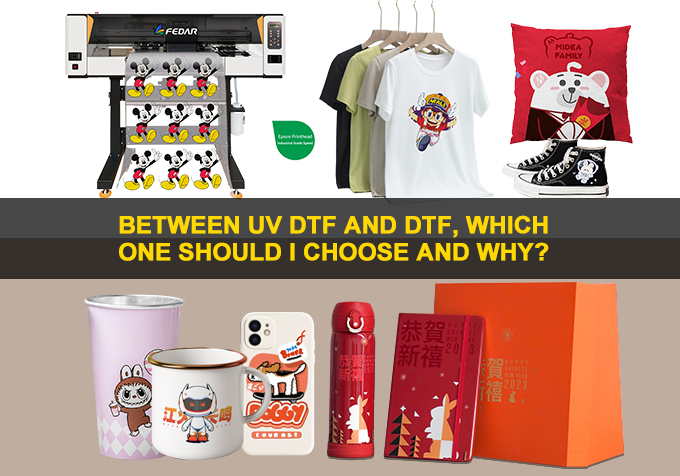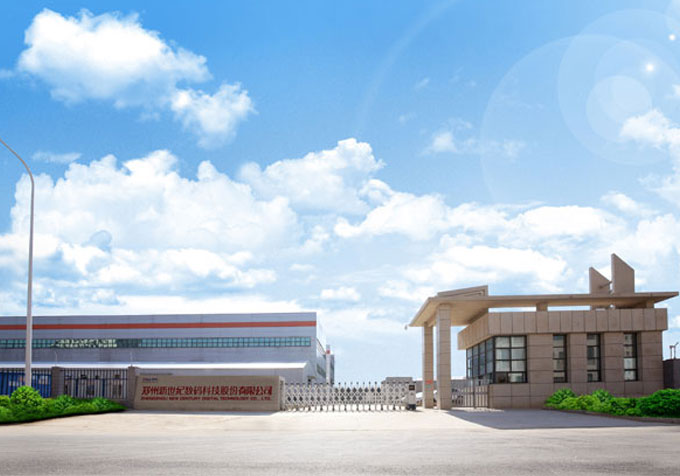Are you looking for a printer that is suitable for your printing business? In this article, we will take a detailed look at the differences between DTF and UV DTF. After reading it, I believe you will know exactly which printing technology is best suited to your requirements.

What is dtf(Direct to Film) printing?
DTF(Direct-to-film) printing is a new innovative digital textile printing process in which high-resolution images are printed onto DTF PET films using special water-based inks. This printed film is called a DTF transfer film and can be hot-pressed onto a variety of substrates to produce high quality designs!
What is uv dtf printing?
UV DTF (Direct To Film) printing is a new type of small advertising printing process, high resolution images are printed on UV DTF film by ultraviolet curing ink. This printed film is called UV DTF AB film, also can be called UV transfer sticker, then the UV DTF film can be peeled off just by pressing with your fingers, no heat pressure is needed, thus producing vivid full-color designs with high quality and durability.
Differences between DTF and UV DTF
Differences between DTF and UV DTF printing processes:
DTF: The DTF printer is used to print the pattern onto a certain type of film in DTF printing. It's a great way to get the perfect pattern on your fabric! Now for the fun part! Using a heat press, the printed film is pressed onto the garment, and the pattern sticks to the cloth once the adhesive powder has been applied and allowed to set.
In UV DTF printing, the pattern is printed onto the film using a dedicated printer. UV rays instantly cure inks used in printing, speeding up the drying process and ensuring patterns stick to the substrate!
Different color vitality:
DTF: They can have bright colors, but the color intensity will vary depending on the quality of the ink and film.
UV DTF: UV DTF printing is incredible! Thanks to the rapid curing process of UV inks, the color vitality and clarity of these prints are truly outstanding.
Application scenarios of the two processes:
DTF application: Suitable for all kinds of fabrics. AGP DTF printers can print a variety of special patterns and images on T-shirts, shirts, jeans, skirts, sweatshirts, vests, coats, hats, shoes and other clothing products.
Applications for UV DTF printing: You can print on a variety of materials, including glass, metal, acrylic, wood, ceramics, plastic, cardboard, and more. Whether you print flat or curved items, this printer is perfect for you.
Consumables comparison:
Type of ink:
DTF Ink: Water-based ink
UV DTF Ink: UV DTF uses oil-based UV ink, so the UV DTF printer is equipped with a UV lamp to fix the color while printing. it is important to remember that the ink must be kept away from light.
The printing film of the two is different:
Only one type of
DTF printing film is required, but the printing film is divided into single-sided and double-sided, or cold tear and hot tear, depending on the different needs of the customer.
UV DTF printing film: When used between A film and B film, UV DTF printing film offers the best of both worlds, making it a fantastic combination! A film is an ink absorbing layer that combines with its own adhesive layer as a printed film. Once printed, the B-film is automatically coated to form a protective and transfer layer. The process is completed by UV DTF without the need for intermediate manual coating. This process is completed by UV DTF, eliminating the need for manual coating in the middle.
Cost comparison between UV DTF and DTF:
DTF Printing: More cost-effective, especially for garment printing, as it uses standard inks and adhesive powders.
UV DTF Printing: Normally more expensive as UV light technology and UV-curable inks become more expensive.
DTF and UV DTF Market Expectations
DTF Printing: There’s no doubt about it: DTF printing technology is on the rise! There are so many forecasts and trends pointing to continued growth and development. The future is bright for printers! Technology will continue to advance, resulting in more efficient and higher-quality printers. This could include some amazing improvements in speed, color accuracy, and the ability to print on a wider range of substrates.
UV DTF Printing: UV printers are shaking up the traditional industry trend and have a promising market outlook! They can undertake large-format digital printing, and can get a fantastic solution regardless of the material! High-definition pictures or photos can achieve the effects of no color difference, high speed, quick drying, and environmental protection, and form a high-precision and detailed picture or embossed convex effect in one go. It's truly amazing! It doesn't matter which way you look at it, progress and innovation are the driving forces behind UV printers.
Conclusion:
DTF and UV DTF printers have a lot in common, but there are also some differences.
If you want to enter the apparel printing industry, DTF printers are the absolute best choice! While UV DTF printers are mainly used for hard substrates such as glass, mugs, wood, acrylic, crystal, etc..
FAQ:
Which Direct to film printers are best for small business?
- A3 DTF printer, 30cm, small footprint, low cost, high efficiency, mass popularity
You can use it to print common applications, customize children's clothing, parent-child clothing, logo customization, and print on fabrics such as hats, canvas bags, socks and pillows.
What materials can UV DTF printers print on?
-They can print on substrates such as wood, plastic, ceramic, metal, leather, PET, acrylic, glass, etc.
Are UV DTF prints wear and scratch resistant? Can they be washed?
-Yes, with TEXTEK's UV inks the prints are abrasion and scratch resistant and can be washed.
How long do UV DTF transfers last?
-It can last from 2 to 5 years.
If there's anything we can do to further showcase machines' features, please let us know.
Email: sale@fedar.net
Whatsapp: +86 15515715397
Our company has over 30 models of printers with independent intellectual property rights and patents. Marketed under the esteemed brands of
Skycolor,
Stormjet, and
Fedar brands, these printers cover a wide range, including digital textile printers, UV printers, eco-solvent printers and more. Known for their exceptional quality and performance.



